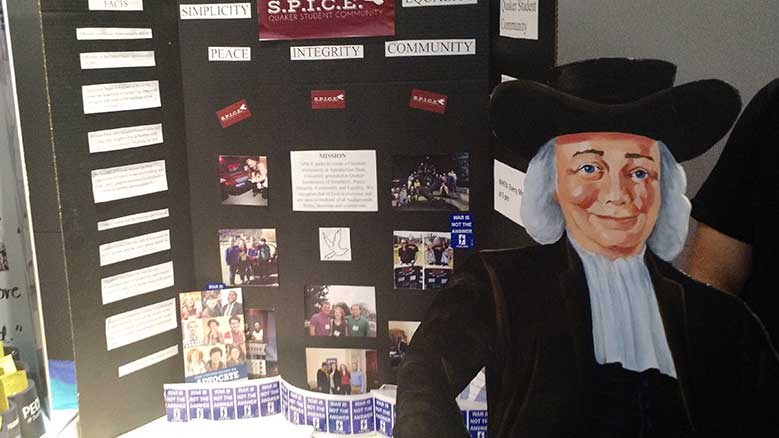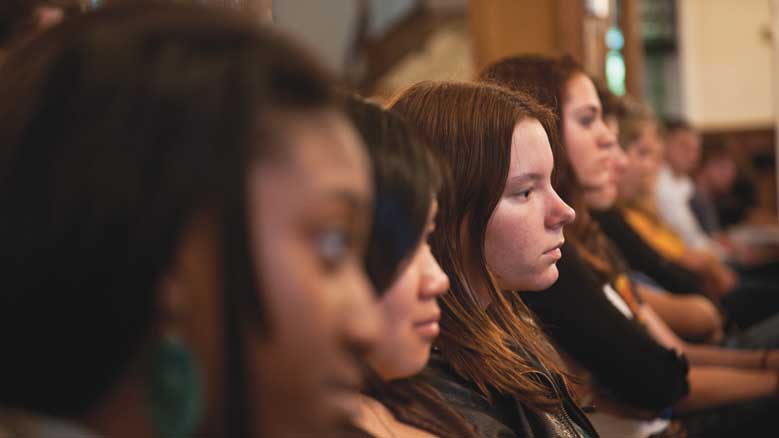You can raise a Quaker without First-day school, without lesson plans, even without figuring out "what every Quaker child needs to know about Quakerism"—but you can’t raise a Quaker without community. Young people raised among Quakers become Quakers for much the same reason people who come to Quakerism as adults do. They get hooked on the experience of spiritual community; they become passionate about the truths learned by plunging into the living water together. Even if no one ever quoted Scripture to them—"love ye one another"—still they understand, hunger for it, and come back for more.
I never set out to raise Quakers. Being new to Quakerism myself, it would have seemed presumptuous. Being a member of a very small and invariably silent worship group, there was no First-day school to offer. There were stories and songs in the home, silent grace at dinner time—but no religious education curriculum, and the stories in the home were more likely Buddhist dharma tales from their storyteller father. There were certainly books—read-alouds at a young age; and as the children grew older a choice book tailored to his or her nature might be offered, or simply left out on the table to be grabbed. Add all of this to the conversations in the family and you have a "no lesson plan" version of spiritual instruction. These things are all part of raising children—but none of this would make them Quakers.
"It takes a village to raise a child," says the African proverb. Well, it takes a meeting to raise a Quaker. The Quaker communities that raised my children were the teen meetings—meetings of young people and their adult leaders and other adult friends—of the yearly and quarterly meetings. These infrequent but intensely experienced meetings can have a huge impact on young lives.
Going to Pacific Yearly Meeting was, at first, another homeschool offering on my part. Not a professional teacher, and a lazy non-teacher at that, my chief gift as a homeschooling mom was the ability to notice the difference between the "clunk" or "ding" reaction when a resource or experience was offered. Yearly meeting for my preteen son was a bigtime "ding!" It became a necessary event in our year. Participating in Junior Yearly Meeting (JYM) for five days in the summer, starting at age 11, leavened Michael’s whole year.
Like many other young people, Michael bonded to meeting for business and worship sharing long before he had any comprehension of meeting for worship. The catch, of course, is that to participate effectively in meeting for business or worship sharing, you have to "get" sitting with expectation and acceptance in the Silence. From the results, the JYMers seemed to take to it as though born to it, and it is indeed supremely innate to the human spirit to sit together in a sacred circle. The year we adults at Pacific Yearly Meeting were struggling painfully with our somewhat legalistic minute on the civil right of same-sex marriage, JYM brought to plenary their own penetrating and simply worded minute. For the teens, the experience of connection with the Spirit leading to heartfelt action left a lasting imprint. For the rest of us, the JYM minute helped us to see past our conflicting emotion to the heart of the matter—to the reality of how much we do love and celebrate each other. And I believe that many of us, while loving the ring of truth, also loved that the message came from our children.
The girls entered JYM five years after Michael, my daughter Faith and first one friend (because it would be more fun with a friend) and then two more friends (because they heard about the good times and asked to come). By that time there was also a quarterly teen program and they all absolutely had to go every quarter—never mind the seven-hour drive each way. The exuberant energy of four girls, myself, and all our gear in a little Subaru was fantastic! The girls explained to me that teen Quaker gatherings were the place where they could be their real selves and be accepted—they could say whatever they wanted or needed to say. They talked intimately in worship-sharing mode about drugs, about relationships between men and women, and about sexual orientation. They thought together about war and about the planet. They learned to run meetings, to appoint clerks and committees, to plan their own gatherings, and to respond to things that happened at those gatherings. They rough-housed and stayed up late—sometimes just "hanging out" and sometimes in a late-night worship that would start at 11:00 and leave most of those gathered in tears. God bless their gifted (and often underappreciated) adult leaders who entered into and guided their community!
As young adults, four of five of these children are still actively involved with Quaker community: one a member of a meeting, another an attender, and another attending a Quaker college. Most notable, though, is that all four are active in the young people’s community that drew them to Quakerism in the first place—active in yearly meeting, and in the Western Young Friends New Year’s Gathering. It is a joy to watch them go off to New Year’s Gathering together and to share the deep commitments of their earnest young lives. My gratitude to the meetings that helped me raise them is deep.
The weakness of the teen meeting system that I experienced was its isolation from the rest of the community of Friends. Looking back, I have wished for these children to have also had the experience of being cherished by a monthly meeting from early childhood. I have heard adult Friends talk movingly of the love and acceptance they felt as children from elders in their monthly meeting. I also wish for more of the adults in our monthly meetings to share the life and light of the young people. So many young people drop out of meeting starting at around age 11—about the age when the great mystics of many traditions were experiencing their first searing mystical experiences—and about the age when the teen meetings were beginning to make their deep impression on the lives of the children in my care.
The Quaker abolitionist John Woolman was deeply fixed in his mid-20s on his concern for slaves and slaveholders. He traveled extensively in the ministry, speaking his message with earnest love. Where can we find among ourselves the young Woolmans of today? Are they embedded in our meetings, or have we cut many of them loose a decade or more earlier? If we as meetings could stay in contact with our teenagers, we might have more fire and less comfort—and that might well be a good thing for us and for the world!




